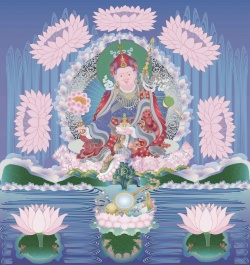Bindu (symbol)
- See also :
- See also :
Bindu (Sanskrit: बिंदु) is a Sanskrit term meaning "point" or "dot". The feminine case ending is bindi which denotes a small ornamental, devotional, and often mystical dot that is cosmetically applied or affixed to the forehead in Hinduism.
Philosophy
In metaphysical terms, Bindu is considered the point where creation begins and may become the unity. It is also described as "the sacred symbol of the cosmos in its unmanifested state".
The bindu is the point around which the mandala is created and represents the manifestation of the universe.
The bindu is often merged with seed, or sperm and ova. The Yoga Chudamani Upanishad states that the bindu exists as a duality, with a white bindu representing shukla (sperm) and a red bindu representing maharaj (menses). The white bindu resides in the bindu visarga and is related to Shiva and the Moon, while the red bindu resides in the muladhara chakra and is related to Shakti and the Sun. . In yoga, it is the
joining of these two parts that results in the ascension of the kundalini to the sahasrara.
Bindu Chakra
Tantric chakras
Sahasrara
Ajna
Vishuddha
Anahata
Manipura
Swadhisthana
Muladhara
Bindu
In Tantra, bindu or bindu visarga ("falling of the drop") is a point at the back of the head, in the same place where Brahmins grow their tuft of hair. This point exists below the sahasrara chakra and above the ajna chakra and is represented by a crescent moon with a white drop. It represents the manifestation of creations, such as consciousness.
The bindu visarga is said to be the source of bindu fluid containing a nectar (amrita) and a poison. The fluid is released from the bindu visarga
where it can be stored in the lalana chakra and purified in the vishuddha chakra. When the vishuddha is inactive, the fluid flows to the manipura chakra where it is consumed and leads to physical degeneration. According to the Hatha Yoga Pradipika, a hatha yoga practitioner can prolong his
or her own life by controlling the flow of the fluid. Through practice of the Khecari mudra, the practitioner can manipulate the flow of the fluid from the lalana into the vishuddha where it is purified to amrita.
Bindu refers to an aspect of the anatomy of the 'subtle body' composed of 'drops' (Tibetan: ཐིག་ལེ thig le) and 'winds' (Tibetan: རླུང rLung): "the drops and winds are features of the human energy system and have varying degrees of subtlety.

